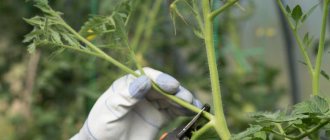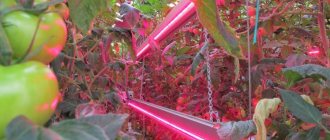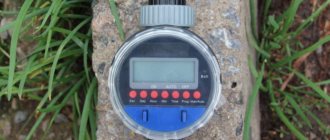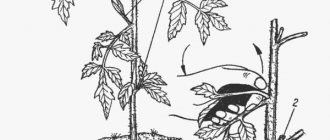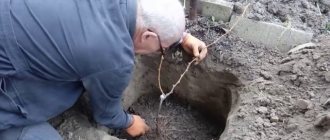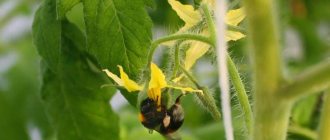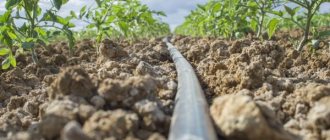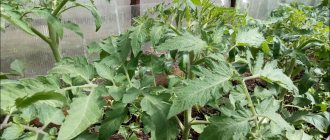Greenhouse/Forming
Formed bushes give the best harvest
If summer in Russia lasted not three, but five to six months, the topic of growing tomatoes in a greenhouse would not be relevant - during this time all the resulting fruits would have time to ripen. But in our conditions we have to limit the number of ovaries in order to get a decent harvest. How to do it right?
- 1 Why do you need pinching and finishing?
- 2 How to properly plant tomatoes 2.1 Removing the shoots
- 2.2 Pinching the tops
- 2.3 Trimming
Why is it necessary to form tomatoes in a greenhouse?
It’s worth starting with the right choice of varieties. Hybrids and indeterminate varieties are best suited for the greenhouse. They will give you a harvest until frost.
To get a rich harvest of tomatoes, the power of the plant must be directed into the development of fruits
And it would be much easier if the tomato bushes grew exclusively upward. But no. Tomatoes have a distinctive feature: in addition to the main trunk, they also like to produce side shoots, the so-called stepsons. They grow in the axils of the leaves, most often with one or two stepsons in each axil. But if you feed your tomatoes like the grandmother of your beloved grandson, then stepsons will appear even on the leaves. And it would seem that there is something wrong with this: big bushes mean a big harvest. But it was not there.
The least of the inconveniences is that by mid-summer you will not even be able to enter the greenhouse. The tomato forest will grow so wide that passage will be very, very difficult. In addition, all the plant’s strength will go into this riot of greenery, and there simply won’t be enough nutrition and short summer for the development and ripening of fruits.
Stepchildren on tomato bushes
And the most unpleasant thing is that in such thickets, diseases feel like at a resort. In poorly ventilated thickets they have complete freedom. Considering all of the above, we conclude: in order to get the maximum yield in a limited area and at the same time avoid contamination of plants and soil, tomato bushes need to be formed.
Formation of determinant varieties
When choosing a type of tomato to grow in a greenhouse, you should familiarize yourself with video reviews from experienced agronomists. Determinate varieties are chosen if the greenhouse is not very tall. Such tomatoes come in several types: low-growing (up to 1 m), medium-growing (up to 1.5 m). The bush will stop growing when the number of ovaries specified for a given variety is formed. Usually, it does not exceed 5. The so-called super-determinant types of tomatoes have fast ripening times. These hybrids are not distinguished by their branchiness, and stepchildren practically do not grow on them. They are easier to care for and the harvest is harvested earlier. But, of course, it will not exceed the volume of the yield from indeterminate tomatoes.
Tomato ovaries
To increase the harvest of fruits from one bush, determinate tomatoes are formed into two or three stems. It is not recommended to leave a larger number of shoots, as this will increase the ripening period and affect the weight of the fruit. The formation of each stem is carried out in the same way as described above. It is worth pinching the top of each of them after 4-5 bunches of tomatoes appear.
How to shape
Gardeners recommend different methods for forming a bush. But they all agree on one thing - no more than three stems and no more than eight brushes.
Instructions for planting tomatoes.
- The first pinching is carried out 15–18 days after planting the seedlings in the greenhouse. Subsequently, repeat every 10–14 days.
- The stem on which the first flower cluster formed is considered the main one.
- All shoots that form between the main stem and leaves are stepsons. When they reach 5–6 cm they must be removed.
Stepping up a bush
Advice. It is recommended to remove the stepsons by breaking them off. It is best to do this in the morning.
The stepsons should not be removed at the root, but should be left 2-3 cm. This will help avoid the re-formation of the stepson in this place.
When forming a single-stem bush, it is necessary to remove absolutely all shoots. When forming a bush into two stems, the shoot located below the first brush and closest to it is left. The shoots on the second stem must be removed in the same way as on the main one.
Scheme of tomato bush formation
Each stem should retain no more than four tassels.
Advice. To get an early harvest, you need to pinched several bushes so that no more than three remain, remove the rest and pinch the tops. Then the plant’s forces will be directed to the ripening of the fruits, and not to the growth of the bush.
Tomato bushes must be tied with pegs so that the stems do not break from the load of fruit.
Is it necessary to plant tomatoes?
Pinching is the process of removing excess vegetation from a bush. Pinching tomatoes is necessary so that the plant does not waste its plastic substances on excess vegetation. After pinching, the plant distributes its beneficial substances between the fruits and leaves from which they feed.
Types of formation and pinching of tomatoes.
Stepchildren should be removed when their length does not exceed 3-4 cm, otherwise wounds will remain on the stem of the plant, and the beneficial substances will already be used up on them.
What to do if your stepsons have already grown beyond 4 cm? Is it possible to leave them? Of course you can. The bushes will grow rapidly, branches will stretch out from each axil, and additional stems will also appear on them. But in this case, remember that the harvest will completely depend on external conditions and on the variety, and it is unknown what to expect in the fall.
It is worth remembering that not only indeterminate varieties (with unlimited growth) are highly branched, for example, the Shaman F1 variety. Determinate varieties with 5-7 inflorescences also produce a lot of extra inflorescences, for example, varieties La-la-fa F1 or Blagovest F1.
The growth of green mass noticeably decreases during the appearance of the first fruits. But these fruits take so long to fill that during this time more than a dozen new ones are formed on the tomato; as a result, all these tomatoes share nutrients among themselves, of which there is not much anyway (after all, everything went to “feed” the greens). In terms of quantity, the harvest is quite large, 15-20 fruits from one bush, but in terms of quality they are small, and they take a very long time to ripen.
When is it recommended to plant tomatoes?
Practice shows that the most “last” day for stepsoning is August 1st. Experienced gardeners and vegetable gardeners advise leaving on the bush only those fruits that formed before August 1st. It is believed that inflorescences and shoots formed later only waste and take away useful substances from fruits, which could fill out and increase in size much faster.
In order not to waste nutrients, you should do it on the specified day (+/- 1 day)
Scheme for pruning overgrown tomato seedlings.
carry out stepsoning. This procedure is carried out only once; absolutely all stepsons should be removed from each plant (bush), leaving 2-3 leaves above the already set fruits; do not forget to pinch the growth points on productive shoots. Of course, it’s a pity to pick off inflorescences that have just appeared, but do it anyway to preserve large shoots.
There is another way to deal with excess vegetation. You need to get rid of it regularly, once every 10 days. Use the following rule: if the formation takes place in 3 stems, we save the main shoot and 2 lower stepsons; in 2 stems, we save the main shoot and the lower stepson under the first inflorescence; in 1 stem, we save only the main shoot.
How do you determine how many stems to leave? This number will tell you the selected plant variety. To obtain the earliest varieties, you should choose low-growing varieties, such as Leopold F1, Biathlon F1, and leave 1 or 2 stems on them. In this case, the tomatoes will ripen on the first 3-5 inflorescences. Remember that each stem bears 3 inflorescences. Therefore, if you leave a bush with three stems, the harvest will ripen much later than on the neighboring bush with one stem.
Let's consider growing tomatoes on determinate varieties and hybrids
To get an early harvest, choose determinate varieties. Plant tomatoes in greenhouses, leaving one stem and 2-3 inflorescences. When the excess shoots are cut off, do not forget to pinch the growing point. Otherwise, the tomatoes will take a long time to ripen.
You can leave 2 stems and 5-7 inflorescences on them, the tomatoes will grow on the bush. Forming inflorescences from 3 stems is impossible.
Scheme of pinching determinate tomatoes
If you leave 1-2 stems and 2-4 inflorescences, then the tomatoes will grow in early July, that is, 13-16 days earlier than usual (without pinching). Of course, the number of fruits per bush will be smaller, but they will be large and ripen quickly. To increase the yield, you can plant the plants a little closer: after 25-30 cm, rather than after 35 cm.
By the way, if you live in central Russia, then you can get a good harvest without pinching. Then you should choose the varieties Boni, Betta, Gavroche, MM, Yamal, Raketa, Alaska, Red Banana, Watermelon. The formation of fruits and their quantity directly depends on the weather. The warmer the summer, the more abundant the tomato harvest.
How to grow tomatoes in greenhouses?
Tomato planting scheme.
It is necessary to grow tomatoes in a greenhouse in order to extend the fruiting period and obtain higher yields per unit area.
If you want to get a harvest in a short time, then use determinate varieties (see above).
And if your region allows you to grow tomatoes in a greenhouse for 4-5 months, then semi-determinate and indeterminate are suitable. A good semi-determinate tomato variety is Magnus F1, which limits growth after the formation of 8-10 inflorescences on the main stem.
For such varieties, it is recommended to leave 1 stem and a continuation shoot under the first inflorescence. As soon as 2-3 inflorescences and several leaves appear on this shoot, it should be pinched to stop the growth of the bush.
If semi-determinate and indeterminate varieties are grown for 4-5 months without stepsons, they will simply stop growing. That is why you should form a reserve shoot, which is located under 2-3 inflorescences from the top of the bush. Otherwise the continuation shoot will not grow. Next we observe the continuation shoot: if it grows, then we remove the reserve shoot, and leave a new one closer to the top of the stem.
It is recommended to plant tomatoes; tomatoes in a greenhouse much more often than in open ground, once every five to seven days.
If the formation of tomatoes occurred on medium and high branches, then there is no need to leave a reserve shoot. After all, the appearance of inflorescences on a reserve shoot no longer stops the growth of plants. “Low-growing” tomatoes in a greenhouse are also good in their own way; they can produce more tomatoes and ripen in a short time.
The main rule of greenhouse cultivation is the following: the less time the tomatoes are in the greenhouse, the fewer inflorescences they will have on the main stem, therefore, the plants can be planted more densely than usual.
ParnikiTeplicy.ru
Pinching the tops
When the required number of clusters with flowers has grown on each stem, it is necessary to cut off the top of the bush. This stage of bush formation is necessary in order to stop the growth of the bush upward and direct all the nutrients directly to the fruits that have already formed. New ovaries will not have time to ripen anyway, so there is no point in wasting energy on them.
Pinching the top of the bush
Each tomato stem is cut off, leaving two leaves on top of the bunches.
Tomato garter
I also want to note that the tomato must be tied up. This plant has a weak trunk that cannot bear the full weight of leaves and fruits. Without support, the plant will lie on the ground.
And in order for the plant to be well ventilated, healthy and bear fruit for a long time, it is not enough to remove the stepsons and some of the leaves. After all, if we leave it to grow lying on the ground, then we will not see a good and, especially, long-lasting harvest, all for the same reason - late blight, and there will be little sun.
Therefore, I recommend tying up tomatoes. Everyone does it in their own way. Some people drive sticks into the ground, huge sharpened stakes and tie each plant, others tie it to the arches. I think this is not important. It’s more convenient for me to dig in U-shaped trellises made of wooden slats (they are reusable), and I tie each plant to the transverse slats with a synthetic rope.
Some people do it with twine. Whoever likes it. If the plant is formed into one trunk, then I tie it to it, first making a large loop (with a reserve for growth, the trunk will get thicker), and then I twist the rope around the trunk counterclockwise to the very top and loosely tie it to the transverse rail. If anything, I'll pick it up later.
The fact that you need to tighten it counterclockwise is an important point. Since the tomato turns to follow the sun, if the rope is wound in some other way, it will simply fall off it.
If the tomato is determinate and has 2 trunks, then I tie them both up. In the case of cherry trees, I tie them with several ropes on different sides so that the branches do not lie on the ground.
By the way, last year I didn’t have enough slats for all the tomatoes and two cherry bushes were left lying on the ground. It turned out to be such a spontaneous experiment - the harvest from these bushes was much more modest compared to the others, and the fruits began to rot while still on the branch. Therefore, you still need to tie it up.
On a note! The most important thing when growing tomatoes is to remember where they come from - it is a warm, dry region. Hence the necessary care - he needs to be provided with conditions as close as possible to his homeland, namely: good lighting, dry air, ventilation, moderate soil moisture.
Leaf trimming
The need to trim leaves when growing tomatoes in a greenhouse has been causing heated debate among gardeners for a long time. Some of them claim that it is necessary to completely remove all leaves. This, in their opinion, prevents both fungal infections and wasted energy of tomato bushes on leaf growth. In addition, this provides greater access to air and lighting for the bush. With this formation, only the top two or three leaves are left.
Removing the lower leaves from a tomato bush
Other gardeners argue that complete pruning of leaves disrupts circulation, thereby destroying nutritional processes, and also limits the photosynthesis of the plant. This part of tomato experts recommends removing only the lower leaves on the plant, as well as yellowed and dried ones.
Advice. You can choose the best method for yourself. Make part of the tomato bed with leaves, and cut the other part and look at the result.
There are many methods for forming a bush. Each gardener does this in his own way. However, everyone has the same goal - to get the maximum yield from a small area. If all agrotechnical measures are carried out correctly, you will create favorable conditions for weight gain and fruit ripening.
Bush formation should be carried out only with sterile instruments
You can watch the video in detail about the formation of tomato bushes in a greenhouse.
Proper watering of tomatoes
Also, as I wrote above, the condition for long-term fruiting is moderate soil moisture and dry air. Pruning and removing leaves is already half the success. All that remains is to carefully water the bush from a hose (preferably with a sprayer at the end) under the root and mulch with something.
I cover the ground with mowed grass, after letting it dry a little in the sun. I water on top of the grass, it dries out quickly, but the ground underneath remains moist. Thus, tomatoes should be watered no more than once every 3-4 days. Below, moreover, there are no leaves, only a bare trunk, which will also dry out quickly. And all the green mass at the top will be dry and water will not touch it.
The tomato must be tied up.

